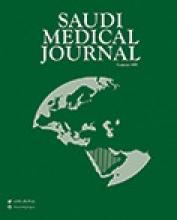Abstract
OBJECTIVE: Hodgkin's disease is one of the most common malignant lymphomas affecting the younger population. This disease has diversified pathologies and clinical stages that necessitate a well optimized clinical management. Regular updating of epidemiological behavior of Hodgkin's disease is obvious from various parts of the world; however, studies from the Kingdom of Saudi Arabia (KSA) in this field are scanty and more than a decade old. The aim of this study was to investigate the current trends in presentation and distribution of Hodgkin's disease with special reference to gender, age, histopathological subtypes, and clinical stages of this disease in Saudi patients.
METHODS: A total of 142 Hodgkin's disease patients attending 2 referral hospitals (King Khalid University Hospital and Security Forces Hospital) in Riyadh, KSA, were included in this study. The records from the questionnaires were analyzed retrospectively for determining the trends of Hodgkin's disease in Saudi adults, over a period of 15 years (1985-2000).
RESULTS: There were 86 males and 56 females, with a male to female ratio of 1.53:1. The mean age of the patients was 28.63 years, while most of the patients were <40 years (80.3%). Nodular sclerosis was the most frequent pathology. Presence of B symptoms had a significant correlation with histology type as well as clinical stage of Hodgkin's disease. Time course analysis showed the increasing trend of Hodgkin's disease frequency, especially in younger adults. The rate of nodular sclerosis continued to increase during the entire course of study whereas the frequency of other histology types showed a decreasing trend during 1992-2000.
CONCLUSION: To the author's knowledge, this is the largest case series of adult Hodgkin's disease from KSA. The results of this study revealed a different pattern of Hodgkin's disease as compared to earlier studies reported from this region. These findings provide valuable insights in the understanding of current epidemiological features of Hodgkin's disease in KSA.
- Copyright: © Saudi Medical Journal
This is an open-access article distributed under the terms of the Creative Commons Attribution-Noncommercial-Share Alike 3.0 Unported, which permits unrestricted use, distribution, and reproduction in any medium, provided the original work is properly cited.






